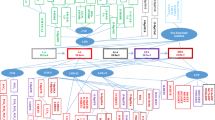Abstract
Glycerophospholipids have been highlighted as the major lipids class affected by trenbolone acetate/estradiol implant administration in bovines. Non-targeted hydrophilic interaction chromatography (HILIC) and reverse phase liquid chromatography (RPLC) coupled to high resolution mass spectrometry have been successfully applied for characterizing lipid profile disruption in serum of implanted bovines. HILIC data pointed towards significant decrease of C22 fatty acids in implanted animals, i.e., C22:3 (p < 0.05), C22:4 (p < 0.05) and C22:6 (p < 0.01), whilst RPLC data confirmed depletion of glycerophospholipids (phosphatidylglycerols, phosphatidylcholine, phosphatidic acid and phosphatidylethanolamine) with C22 fatty acid chains. Using these two complementary methods, complex lipids with the same alkyl chain have been putatively characterized and could further serve to understand the biological mechanism of illicit administration of trenbolone acetate/estradiol implant. These metabolites underpin glycerophospholipid metabolism as potential pathway, which was identified using metabolomic pathway analysis and MetExplore platforms. We hypothesized that implantation of exogenous androgenic and estrogenic steroids induces a depletion of glycerophospholipids with C22 FA chains, by decreasing high-density lipoproteins, the main transporters of glycerophospholipids in plasma.




Similar content being viewed by others
References
Bird, S. S., Marur, V. R., Sniatynski, M. J., Greenberg, H. K., & Kristal, B. S. (2011). Serum lipidomics profiling using LC–MS and high energy collisional dissociation fragmentation: Focus on triglyceride detection and characterization. Analytical Chemistry, 83(17), 6648–6657.
Cajka, T., & Fiehn, O. (2014). Comprehensive analysis of lipids in biological systems by liquid chromatography–mass spectrometry. Trends in Analytical Chemistry, 61, 192–206. doi:10.1016/j.trac.2014.04.017.
Cinci, G., Guerranti, R., Pagani, R., Carlucci, F., Terzuoli, L., Rosi, F., & Marinello, E. (2000). Fatty acid composition of phospholipids, triglycerides and cholesterol in serum of castrated and estradiol treated rats. Life Sciences, 66(17), 1647–1654.
Cinci, G., Pagani, R., Pandolfi, M. L., Porcelli, B., Pizzichini, M., & Marinello, E. (1993). Effects of testosterone on cholesterol levels and fatty acid composition in the rat. Life Sciences, 53(2), 91–97.
Cottret, L., Wildridge, D., Vinson, F., Barrett, M. P., Charles, H., Sagot, M.-F., & Jourdan, F. (2010). MetExplore: A web server to link metabolomic experiments and genome-scale meta-bolic networks. Nucleic Acids Research, 38, W132–W137.
Crook, D., & Seed, M. (1990). Endocrine control of plasma lipoprotein metabolism: Effects of gonadal steroids. Baillieres Clinical Endocrinology and Metabolism, 4(4), 851–875.
Dervilly-Pinel, G., Weigel, S., Lommen, A., Chereau, S., Rambaud, L., Essers, M., et al. (2011). Assessment of two complementary liquid chromatography coupled to high resolution mass spectrometry metabolomics strategies for the screening of anabolic steroid treatment in calves. Analytica Chimica Acta, 700, 144–154.
Dyer, E. G., & Bligh, W. J. (1959). A Rapid method of total lipid extraction and purification. Canadian Journal of Biochemistry and Physiology, 37, 911–917.
Fahy, E., Subramaniam, S., Brown, H. A., Glass, C. K., Merrill, A. H, Jr, Murphy, R. C., et al. (2005). A comprehensive classification system for lipids. Journal of Lipid Research, 46, 839–861.
Gallart-Ayala, H., Chéreau, S., Dervilly-Pinel, G., & Le Bizec, B. (2015). Potential of mass spectrometry metabolomics for chemical food safety. Bioanalysis, 7(1), 133–140.
Gallart-Ayala, H., Courant, F., Severe, S., Antignac, J.-P., Morio, F., Abadie, J., & Le Bizec, B. (2013). Versatile lipid profiling by liquid chromatography–high resolution mass spectrometry using all ion fragmentation and polarity switching. Preliminary application for serum samples phenotyping related to canine mammary cancer. Analytica Chimica Acta, 796, 75–83. doi:10.1016/j.aca.2013.08.006.
Gao, F., Tian, X. K., Wen, D. W., Liao, J., Wang, T., & Liu, H. W. (2006). Analysis of phospholipid species in rat peritoneal surface layer by liquid chromatography/electrospray ionization ion-trap mass spectrometry. Biochimica et Biophysica Acta, 1761, 667–676.
Glazer, G. (1992). Atherogenic effects of anabolic steroids on serum lipid levels: A literature review. Archives of Internal Medicine, 152(3), 535.
Holcapeka, M., Cífkováa, E., Cervenáa, B., Lísaa, M., Vostálováb, J., & Galuszka, J. (2015). Determination of nonpolar and polar lipid classes in human plasma, erythrocytes and plasma lipoprotein fractions using ultrahigh-performance liquid chromatography-mass spectrometry. Journal of Chromatography A, 1377, 85–91.
Horrocks, L. A., & Yeo, Y. K. (1999). Health benefits of docosahexaenoic acid (DHA). Pharmacological Research, 40, 211–225.
Jacob, C. C., Dervilly-Pinel, G., Biancotto, G., Monteau, F., & Le Bizec, B. (2014). Global urine fingerprinting by LC–ESI(+)–HRMS for better characterization of metabolic pathway disruption upon anabolic practices in bovine. Metabolomics,. doi:10.1007/s11306-014-0685-3.
Kessner, D., Chambers, M., Burke, R., Agusand, D., & Mallick, P. (2008). ProteoWizard: Open source software for rapid proteomics tools development. Bioinformatics, 24(21), 2534–2536.
Kitson, A. P., Marks, K. A., Shaw, B., Mutch, D. M., & Stark, K. D. (2013). Treatment of ovariectomized rats with17β-estradiol increases hepatic delta-6 desaturase enzyme expression and docosahexaenoic acid levels in hepatic and plasma phospholipids. Prostaglandins Leukotrienes and Essential Fatty Acids, 89, 81–88.
Koen, S., dos Santos Pereira, A., Vanhoenacker, G., David, F., & Sandra, P. (2010). Comprehensive blood plasma lipidomics by liquid chromatography/quadrupole time-of-flight mass spectrometry. Journal of Chromatography A, 1217, 4087–4099.
Kuipers, H., Wijnen, J. A., Hartgens, F., & Willems, S. M. (1991). Influence of anabolic steroids on body composition, blood pressure, lipid profile and liver functions in body builders. International Journal of Sports Medicine, 12(4), 413–418.
Laron, Z., & Kowadlo-Silbergeld, A. (1965). Effect of testosterone and methandrostenolone (dianabol) on plasma free fatty acids in intact female and castrated male rats. Israel Journal of Medical Sciences, 1, 91.
Merrill, A. H, Jr., Wang, E., Innis, W. S. A., & Mullins, R. (1985). Increases in serum sphingomyelin by 17β-estradiol. Lipids, 20(4), 252–254.
Nebbia, C., Urbani, A., Carletti, M., Gardini, G., Balbo, A., Bertarelli, D., & Girolami, F. (2011). Novel strategies for tracing the exposure of meat cattle to illegal growth-promoters. The Veterinary Journal, 189, 34–42.
Nzoughet, J. K., Dervilly-Pinel, G., Chéreau, S., Biancotto, G., Monteau, F., Elliott, C., & Le Bizec, B. (2015). First insights into serum metabolomics of Revalor-XS® implanted bovines; Screening model to predict hormone-treated and control animals’ status. Metabolomics,. doi:10.1007/s11306-015-0775-x.
Ogiso, H., Suzuki, T., & Taguchi, R. (2008). Development of a reverse-phase liquid chromatography electrospray ionization mass spectrometry method for lipidomics, improving detection of phosphatidic acid and phosphatidylserine. Analytical Biochemistry, 375(124–131), 1820. doi:10.1016/j.ab.2007.12.027.6977.
Okazaki, Y., Kamide, Y., Hirai, M. Y., & Saito, K. (2013). Plant lipidomics based on hydrophilic interaction chromatography coupled to ion trap time-of-flight mass spectrometry. Metabolomics, 9(Suppl 1), 121–131. doi:10.1007/s11306-011-0318-z.
Pinel, G., Weigel, S., Antignac, J.-P., Mooney, M. H., Elliott, C., Nielen, M. W. F., & Le Bizec, B. (2010). Targeted and untargeted profiling of biological fluids to screen for anabolic practices in cattle. Trends in Analytical Chemistry, 29(11), 1269–1280.
Roberts, L. D., McCombie, G., Titman, C. M., & Griffin, J. L. (2008). A matter of fat: An introduction to lipidomic profiling methods. Journal of Chromatography B, 871, 174–181.
Rubinow, K. B., & Page, S. T. (2012). Testosterone, HDL and cardiovascular risk in men. Clinical Lipidology, 7(4), 363–365.
Smith, C. A., Want, E. J., O’Maille, G., Abagyan, R., & Siuzdak, G. (2006). XCMS: Processing mass spectrometry data for metabolite profiling using nonlinear peak alignment, matching and identification. Analytical Chemistry, 78, 779–787.
Solyom, A. (1971). Effect of androgens on serum lipids and lipoproteins. Lipids, 7(2), 100–104.
Sumner, L. W., Amberg, A., Barrett, D., Beale, M. H., Beger, R., Daykin, C. A., et al. (2007). Proposed minimum reporting standards for chemical analysis. Metabolomics, 3(3), 211–221.
Tautenhahn, R., Böttcher, C., & Neumann, S. (2008). Highly sensitive feature detection for high resolution LC/MS. BMC Bioinformatics, 9, 504.
Vorkas, P. A., Isaac, G., Anwar, M. A., Davies, A. H., Want, E. J., & Holmes, E. (2015). Untargeted UPLC-MS profiling pipeline to expand tissue metabolome coverage: Application to cardiovascular disease. Analytical Chemistry,. doi:10.1021/ac503775m.
Wenk, M. R. (2005). The emerging field of lipidomics. Nature Reviews Drug Discovery, 4, 594–610.
Wiesner, P., Leidl, K., Boettcher, A., Schmitz, G., & Liebisch, G. (2009). Lipid profiling of FPLC-separated lipoprotein fractions by electrospray ionization tandem mass spectrometry. Journal of Lipid Research, 50, 574–585.
Xia, J., & Wishart, D. S. (2010). MetPA: A web-based metabolomics tool for pathway analysis and visualization. Bioinformatics, 26(18), 2342–2344. doi:10.1093/bioinformatics/btq418.
Yonezawa, Y., Hada, T., Uryu, K., Iijima, H., Yoshida, H., & Mizushina, Y. (2006). Inhibitory action of c22-fatty acids on DNA polymerases and DNA topoisomerases. International Journal of Molecular Medicine, 18(583–588), 583.
Zuliani, U., Bernardini, B., Catapano, A., Campana, M., Cerioli, G., & Spattini, M. (1989). Effects of anabolic steroids, testosterone, and HGH on blood lipids and echocardiographic parameters in body builders. International Journal of Sports Medicine, 10(1), 62–66.
Acknowledgments
This work was financially supported by the Italian Ministry of Health (RF-IZV-2008-1175188) and the French Région Pays de la Loire. Dr Judith Kouassi Nzoughet was a fellowship recipient of Région Pays de la Loire (Projet acronym: Metaboscreen, Contract No 2011-12706). Thanks to Merck Animal Health that kindly supplied the ear implants Revalor-XS®. Authors would like to thank Dr Gilles Simard for useful discussion on the biological pathway.
Author information
Authors and Affiliations
Corresponding author
Ethics declarations
Conflict of interest
The authors declare no conflict of interest.
Research involving Human and Animal Rights
All institutional and national guidelines for the care and use of laboratory animals were followed. Animals were managed according to Directive 86/609/EEC for the protection of animals used for experimental or other scientific purposes, enforced by the Italian D. Lgs No 116 of January 27, 1992 and Directive 63/2010. The animal study was approved by the Animal Experimentation Ethical Committee of the University of Bologna and was therefore performed in accordance with the ethical standards laid down in the 1964 Declaration of Helsinki and its later amendments.
Electronic supplementary material
Below is the link to the electronic supplementary material.
Rights and permissions
About this article
Cite this article
Nzoughet, J.K., Gallart-Ayala, H., Biancotto, G. et al. Hydrophilic interaction (HILIC) and reverse phase liquid chromatography (RPLC)–high resolution MS for characterizing lipids profile disruption in serum of anabolic implanted bovines. Metabolomics 11, 1884–1895 (2015). https://doi.org/10.1007/s11306-015-0847-y
Received:
Accepted:
Published:
Issue Date:
DOI: https://doi.org/10.1007/s11306-015-0847-y




